Metamaterial Impedance Matching Network for Ambient RF-Energy Harvesting Operating at 2.4 GHz and 5 GHz
Abstract
:1. Introduction
2. MIMN Background and Design Process
3. Experimental Setup to Evaluate the MIMN
4. Experimental Results and Discussion
5. Conclusions
Author Contributions
Funding
Conflicts of Interest
References
- Li, L.; Zhang, X.; Song, C.; Huang, Y. Progress, challenges, and perspective on metasurfaces for ambient radio frequency energy harvesting. Appl. Phys. Lett. 2020, 116. [Google Scholar] [CrossRef]
- Luo, Y.; Pu, L.; Wang, G.; Zhao, Y. RF energy harvesting wireless communications: Rf environment, device hardware and practical issues. Sensors 2019, 19, 3010. [Google Scholar] [CrossRef] [PubMed] [Green Version]
- Luo, Y.; Pu, L.; Zhao, Y.; Wang, W.; Yang, Q. A Nonlinear Recursive Model Based Optimal Transmission Scheduling in RF Energy Harvesting Wireless Communications. IEEE Trans. Wirel. Commun. 2020, 19, 3449–3462. [Google Scholar] [CrossRef] [Green Version]
- Cansiz, M.; Altinel, D.; Kurt, G.K. Efficiency in RF energy harvesting systems: A comprehensive review. Energy 2019, 174, 292–309. [Google Scholar] [CrossRef]
- Alibakhshikenari, M.; Virdee, B.S.; See, C.H.; Abd-alhameed, R.A.; Limiti, E. Energy Harvesting Circuit with High RF-to-DC Conversion Efficiency. In Proceedings of the 2020 IEEE International Symposium on Antennas and Propagation and North American Radio Science Meeting, Montreal, QC, Canada, 5–10 July 2020; pp. 1299–1300. [Google Scholar] [CrossRef]
- Gu, X.; Grauwin, L.; Dousset, D.; Hemour, S.; Wu, K. Dynamic Ambient RF Energy Density Measurements of Montreal for Battery-Free IoT Sensor Network Planning. IEEE Internet Things J. 2021, 4662. [Google Scholar] [CrossRef]
- Karampatea, A.; Siakavara, K. Synthesis of rectenna for powering micro-watt sensors by harvesting ambient RF signals’ power. Electronics 2019, 8, 1108. [Google Scholar] [CrossRef] [Green Version]
- Nintanavongsa, P. A survey on RF energy harvesting: Circuits and protocols. Energy Procedia 2014, 56, 414–422. [Google Scholar] [CrossRef] [Green Version]
- Takacs, A.; Okba, A.; Aubert, H.; Charlot, S.; Calmon, P.F. Recent advances in electromagnetic energy harvesting and Wireless Power Transfer for IoT and SHM applications. In Proceedings of the 2017 IEEE International Workshop of Electronics, Control, Measurement, Signals and their Application to Mechatronics (ECMSM 2017), Donostia, Spain, 24–26 May 2017. [Google Scholar]
- Hemour, S.; Wu, K. Radio-frequency rectifier for electromagnetic energy harvesting: Development path and future outlook. Proc. IEEE 2014, 102, 1667–1691. [Google Scholar] [CrossRef]
- Muncuk, U.; Alemdar, K.; Sarode, J.D.; Chowdhury, K.R. Multiband ambient RF energy harvesting circuit design for enabling batteryless sensors and IoT. IEEE Internet Things J. 2018, 5, 2700–2714. [Google Scholar] [CrossRef]
- Shen, S.; Chiu, C.Y.; Murch, R.D. Multiport Pixel Rectenna for Ambient RF Energy Harvesting. IEEE Trans. Antennas Propag. 2018, 66, 644–656. [Google Scholar] [CrossRef]
- Liu, Z.; Zhong, Z.; Guo, Y.X. High-efficiency triple-band ambient RF energy harvesting for wireless body sensor network. In Proceedings of the 2014 IEEE MTT-S International Microwave Workshop Series on RF and Wireless Technologies for Biomedical and Healthcare Applications (IMWS-Bio2014), London, UK, 8–10 December 2014; pp. 15–17. [Google Scholar] [CrossRef]
- Sun, H.; Guo, Y.X.; He, M.; Zhong, Z. A dual-band rectenna using broadband yagi antenna array for ambient rf power harvesting. IEEE Antennas Wirel. Propag. Lett. 2013, 12, 918–921. [Google Scholar] [CrossRef]
- Shen, S.; Zhang, Y.; Chiu, C.-Y.; Murch, R. An Ambient RF Energy Harvesting System Where the Number of Antenna Ports is Dependent on Frequency. IEEE Trans. Microw. Theory Tech. 2019, 67, 3821–3832. [Google Scholar] [CrossRef]
- Piñuela, M.; Mitcheson, P.D.; Lucyszyn, S. Ambient RF energy harvesting in urban and semi-urban environments. IEEE Trans. Microw. Theory Tech. 2013, 61, 2715–2726. [Google Scholar] [CrossRef]
- Huang, J.; Xing, C.C.; Wang, C. Simultaneous Wireless Information and Power Transfer: Technologies, Applications, and Research Challenges. IEEE Commun. Mag. 2017, 55, 26–32. [Google Scholar] [CrossRef]
- Ponnimbaduge Perera, T.D.; Jayakody, D.N.K.; Sharma, S.K.; Chatzinotas, S.; Li, J. Simultaneous Wireless Information and Power Transfer (SWIPT): Recent Advances and Future Challenges. IEEE Commun. Surv. Tutor. 2018, 20, 264–302. [Google Scholar] [CrossRef] [Green Version]
- Song, C.; Huang, Y.; Carter, P.; Zhou, J.; Joseph, S.D.; Li, G. Novel Compact and Broadband Frequency-Selectable Rectennas for a Wide Input-Power and Load Impedance Range. IEEE Trans. Antennas Propag. 2018, 66, 3306–3316. [Google Scholar] [CrossRef]
- Arrawatia, M.; Baghini, M.S.; Kumar, G. Broadband Bent Triangular Omnidirectional Antenna for RF Energy Harvesting. IEEE Antennas Wirel. Propag. Lett. 2016, 15, 36–39. [Google Scholar] [CrossRef]
- Bhatt, K.; Kumar, S.; Kumar, P.; Tripathi, C.C. Highly Efficient 2.4 and 5.8 GHz Dual-Band Rectenna for Energy Harvesting Applications. IEEE Antennas Wirel. Propag. Lett. 2019, 18, 2637–2641. [Google Scholar] [CrossRef]
- Mattsson, M.; Kolitsidas, C.I.; Jonsson, B.L.G. Dual-band dual-polarized full-wave rectenna based on differential field sampling. IEEE Antennas Wirel. Propag. Lett. 2018, 17, 956–959. [Google Scholar] [CrossRef]
- Pan, N.; Belo, D.; Rajabi, M.; Schreurs, D.; Carvalho, N.B.; Pollin, S. Bandwidth Analysis of RF-DC Converters under Multisine Excitation. IEEE Trans. Microw. Theory Tech. 2018, 66, 791–802. [Google Scholar] [CrossRef]
- Molex. Wifi 6E Flex Cable Balance Antenna Product Specification. 2020. Available online: https://www.molex.com/pdm_docs/ps/PS-146153-100-001.pdf (accessed on 1 March 2021).
- Skyworks Solutions. Surface Mount Mixer and Detector Schottky Diodes. Datasheet. 2016. Available online: https://www.skyworksinc.com/-/media/A36775836A4E4BA8A92104088692424F.ashx (accessed on 1 March 2021).
- Texas Instruments. bq25570 Nano Power Boost Charger and Buck Converter. 2015. Available online: https://www.ti.com/lit/ds/symlink/bq25570.pdf (accessed on 1 March 2021).
- Avx. AVX BestCap Ultra-low ESR High Power Pulse Supercapacitors. 2013. Available online: http://catalogs.avx.com/BestCap.pdf (accessed on 1 March 2021).
- Visser, H.J.; Vullers, R.J.M. RF energy harvesting and transport for wireless sensor network applications: Principles and requirements. Proc. IEEE 2013, 101, 1410–1423. [Google Scholar] [CrossRef]
- Karampatea, A.; Siakavara, K. Hybrid rectennas of printed dipole type on Double Negative Dielectric Media for powering sensors via RF ambient energy harvesting. AEU Int. J. Electron. Commun. 2019, 108, 242–250. [Google Scholar] [CrossRef]
- Chang, Y.; Zhang, P.; Wang, L. Highly efficient differential rectenna for RF energy harvesting. Microw. Opt. Technol. Lett. 2019, 61, 2662–2668. [Google Scholar] [CrossRef]
- Chaour, I.; Fakhfakh, A.; Kanoun, O.; Tran, L.G.; Cha, H.K.; Park, W.T. Enhanced passive RF-DC converter circuit efficiency for low RF energy harvesting. Sensors 2017, 17, 546. [Google Scholar] [CrossRef] [Green Version]
- Marshall, B.R.; Morys, M.M.; Durgin, G.D. Parametric analysis and design guidelines of RF-to-DC Dickson charge pumps for RFID energy harvesting. In Proceedings of the 2015 IEEE International Conference on RFID (RFID), San Diego, CA, USA, 15–17 April 2015; pp. 32–39. [Google Scholar] [CrossRef]
- Mahfoudi, H.; Takhedmit, H.; Tellache, M.; Boisseau, S. Wireless sensor node remote supply using a compact stacked rectenna array with voltage multipliers at 2.45 GHz. Int. J. Microw. Wirel. Technol. 2020, 12, 309–315. [Google Scholar] [CrossRef]
- Pendry, J.B.; Holden, A.J.; Robbins, D.J.; Stewart, W.J. Magnetism from conductors and enhanced nonlinear phenomena. IEEE Trans. Microw. Theory Tech. 1999, 47, 2075–2084. [Google Scholar] [CrossRef] [Green Version]
- Smith, D.R.; Padilla, W.J.; Vier, D.C.; Nemat-Nasser, S.C.; Schultz, S. Composite medium with simultaneously negative permeability and permittivity. Phys. Rev. Lett. 2000, 84, 4184–4187. [Google Scholar] [CrossRef] [Green Version]
- Rennings, A.; Otto, S.; Mosig, J.; Caloz, C.; Wolff, I. Extended Composite Right/Left-Handed (E-CRLH) metamaterial and its application as quadband quarter-wavelength transmission line. In Proceedings of the 2006 Asia-Pacific Microwave Conference, Yokohama, Japan, 12–15 December 2006; pp. 1405–1408. [Google Scholar] [CrossRef]
- Damm, C.; Schüßler, M.; Freese, J.; Jakoby, R. Novel impedance matching approach employing the band gap region of composite right/left-handed artificial lines. In Proceedings of the 2007 European Microwave Conference, Munich, Germany, 9–12 October 2007; pp. 708–711. [Google Scholar] [CrossRef]
- Paredes, F.; Zamora, G.; Bonache, J.; Martin, F. Perturbation method based on resonant type metamaterial transmission lines for dual-band matching networks. In Proceedings of the 2009 Mediterrannean Microwave Symposium (MMS), Tangiers, Morocco, 15–17 November 2009. [Google Scholar] [CrossRef]
- Alibakhshikenari, M.; Virdee, B.S.; See, C.H.; Abd-Alhameed, R.A.; Falcone, F.; Limiti, E. Metasurface for controlling polarization of scattered em waves. In Proceedings of the 2020 4th Australian Microwave Symposium (AMS), Sydney, NSW, Australia, 13–14 February 2020; pp. 13–14. [Google Scholar] [CrossRef]
- Alibakhshikenari, M.; Virdee, B.S.; See, C.H.; Abd-Alhameed, R.A.; Falcone, F.; Limiti, E. Impedance Matching Network Based on Metasurfaces (2-D Metamaterials) for Electrically Small Antennas. In Proceedings of the 2020 IEEE International Symposium on Antennas and Propagation and North American Radio Science Meeting, Montreal, QC, Canada, 5–10 July 2020; pp. 1953–1954. [Google Scholar]
- Günel, T. A genetic approach to the synthesis of composite right/left-handed transmission line impedance matching sections. AEU Int. J. Electron. Commun. 2007, 61, 459–462. [Google Scholar] [CrossRef]
- Güneş, F.; Karataev, T.; Demirel, S. Composite right/left-handed transmission lines in use for ultra-wideband matching of front-end amplifiers with modified cuckoo search optimization. Int. J. Numer. Model. Electron. Netw. Devices Fields 2017, 30, e2144. [Google Scholar] [CrossRef]
- Karataev, T.; Gunes, F.; Demirel, S. Cuckoo search design optimization and analysis of matching circuits composed of CRLH transmission cells. In Proceedings of the 2015 Twelve International Conference on Electronics Computer and Computation (ICECCO), Almaty, Kazakhstan, 27–30 September 2015; pp. 2–5. [Google Scholar] [CrossRef]
- Eleftheriades, G.V.; Iyer, A.K.; Kremer, P.C. Planar negative refractive index media using periodically L-C loaded transmission lines. IEEE Trans. Microw. Theory Tech. 2002, 50, 2702–2712. [Google Scholar] [CrossRef]
- Pozar, D.M. Microwave Engineering; John Wiley & Sons, Inc.: Hoboken, NJ, USA, 2018; ISBN 978-0-470-63155-3. [Google Scholar]
- García-García, J.; Sans, B. Switchable microstrip bandpass-stopband filter based on periodically loaded transmission lines. In Proceedings of the 5th International Conference on Wireless Communications, Networking and Mobile Computing (WiCOM 2009), Beijing, China, 24–26 September 2009. [Google Scholar]
- Chen, Y.S.; Chiu, C.W. Maximum achievable power conversion efficiency obtained through an optimized rectenna structure for RF energy harvesting. IEEE Trans. Antennas Propag. 2017, 65, 2305–2317. [Google Scholar] [CrossRef]
- Chen, Y.S.; Chiu, C.W. Insertion Loss Characterization of Impedance Matching Networks for Low-Power Rectennas. IEEE Trans. Compon. Packag. Manuf. Technol. 2018, 8, 1632–1641. [Google Scholar] [CrossRef]
- Li, P.; Long, Z.; Yang, Z. RF Energy Harvesting for Batteryless and Maintenance-Free Condition Monitoring of Railway Tracks. IEEE Internet Things J. 2021, 8, 3512–3523. [Google Scholar] [CrossRef]
- Vital, D.; Bhardwaj, S.; Volakis, J.L. A 2.45 GHz RF Power Harvesting System Using Textile-Based Single-Diode Rectennas. IEEE MTT-S Int. Microw. Symp. Dig. 2019, 2, 1313–1315. [Google Scholar] [CrossRef]
- Visser, J.; Keyrouz, S.; Smolders, A.B. Optimized rectenna design. Wirel. Power Transf. 2015, 2, 44–50. [Google Scholar] [CrossRef] [Green Version]
- Sun, H.; Guo, Y.X.; He, M.; Zhong, Z. Design of a high-efficiency 2.45-GHz rectenna for low-input-power energy harvesting. IEEE Antennas Wirel. Propag. Lett. 2012, 11, 929–932. [Google Scholar] [CrossRef]
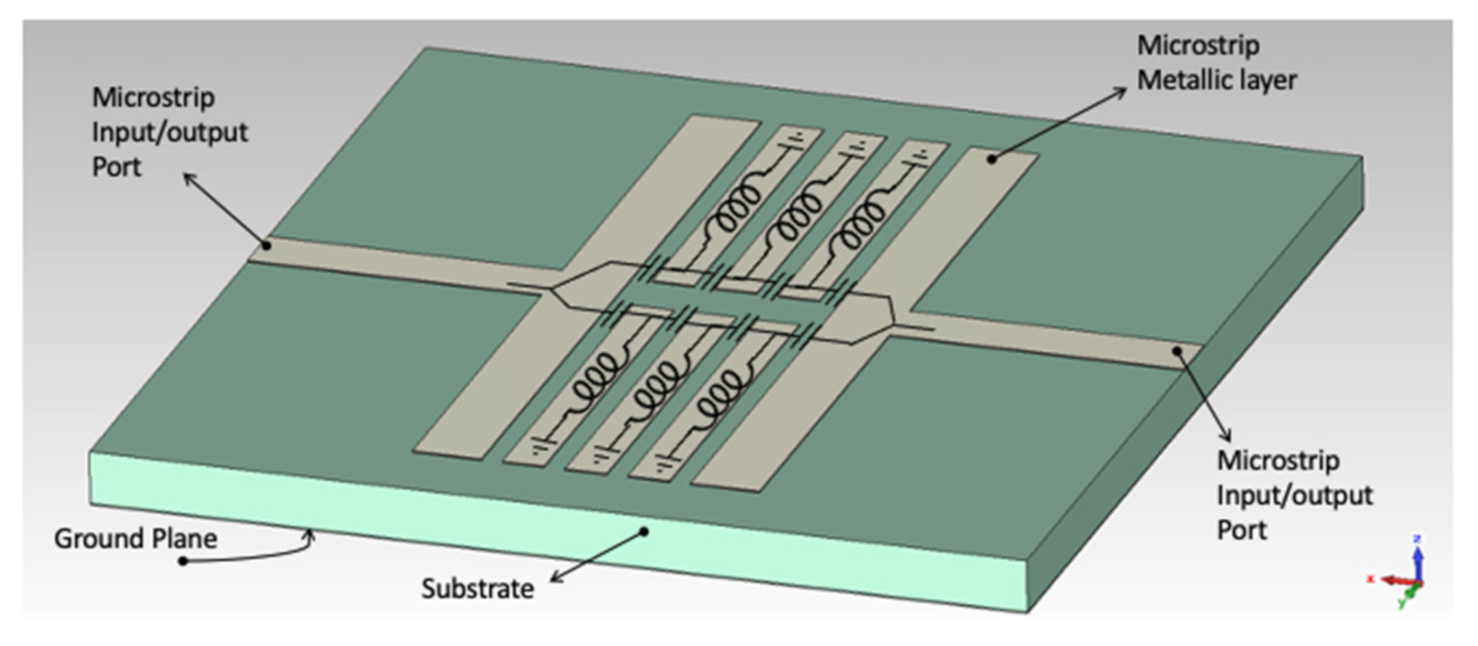




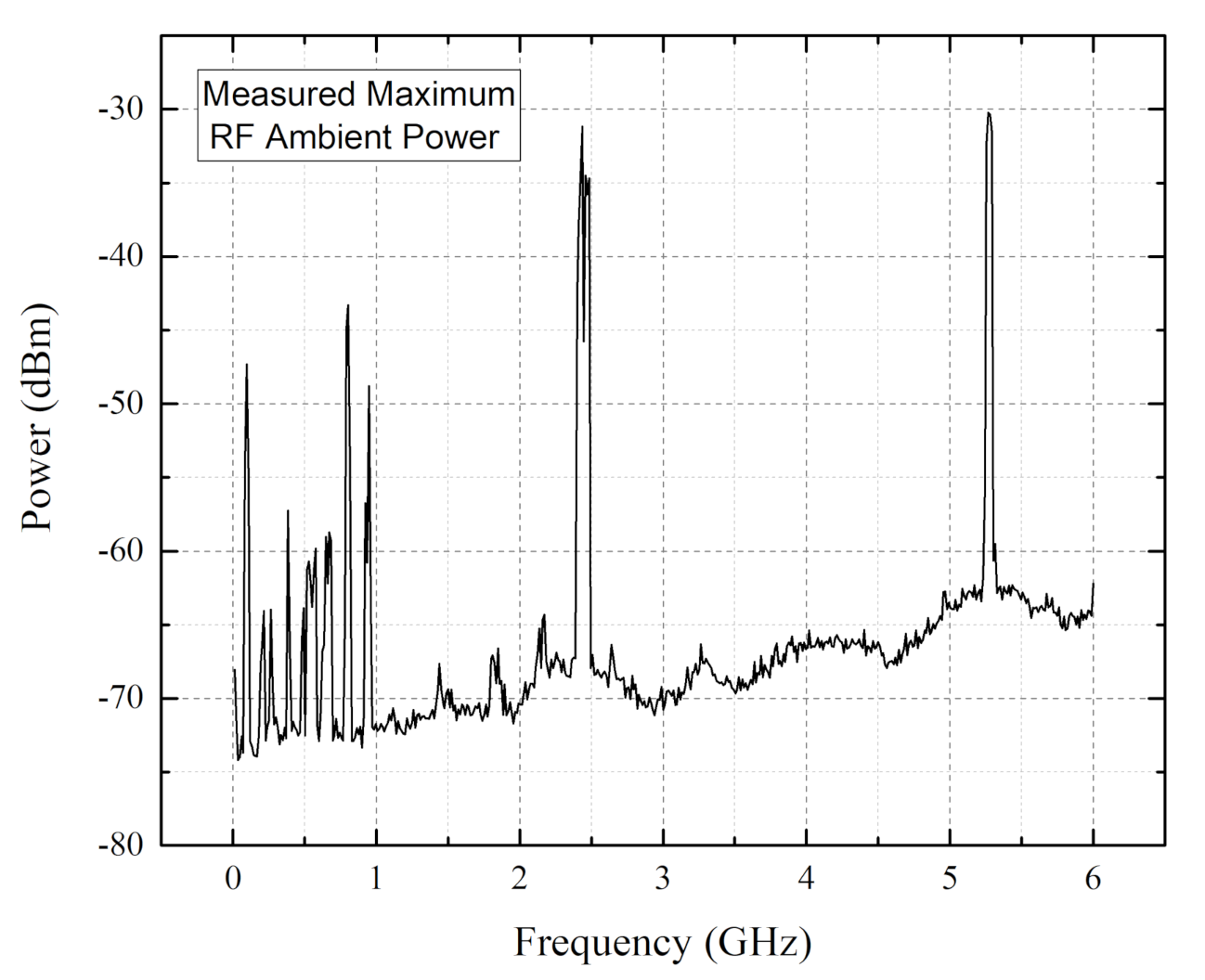
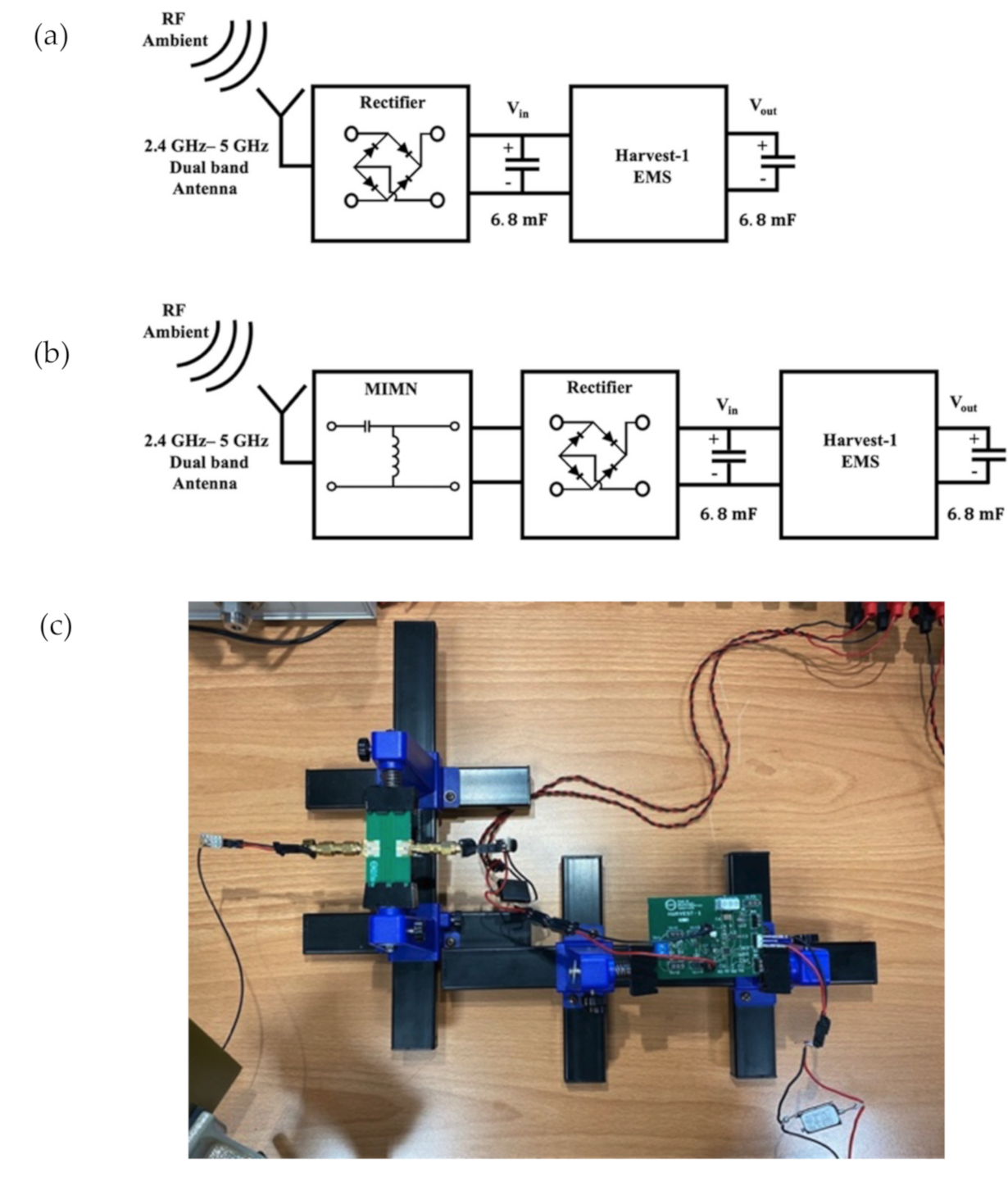
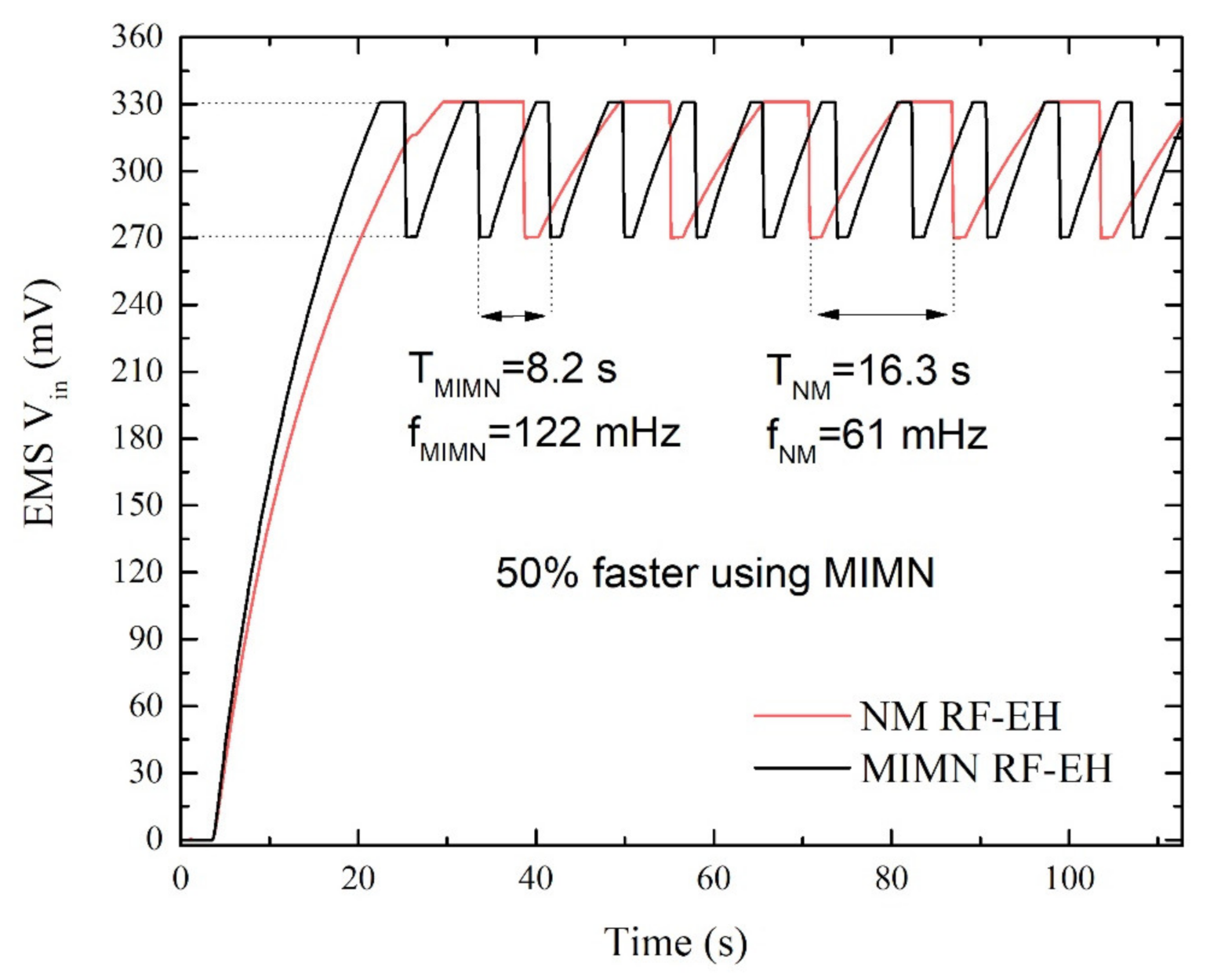
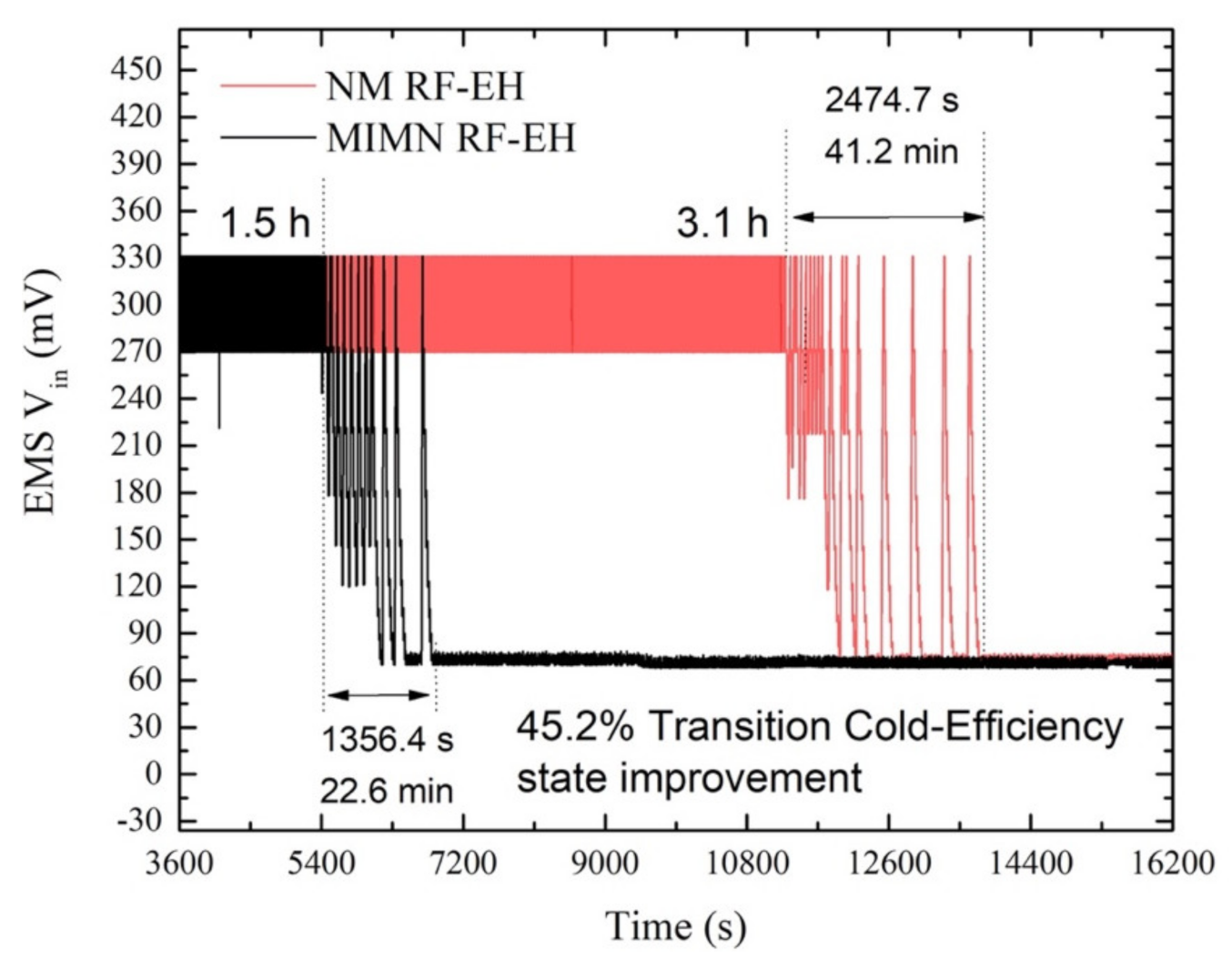
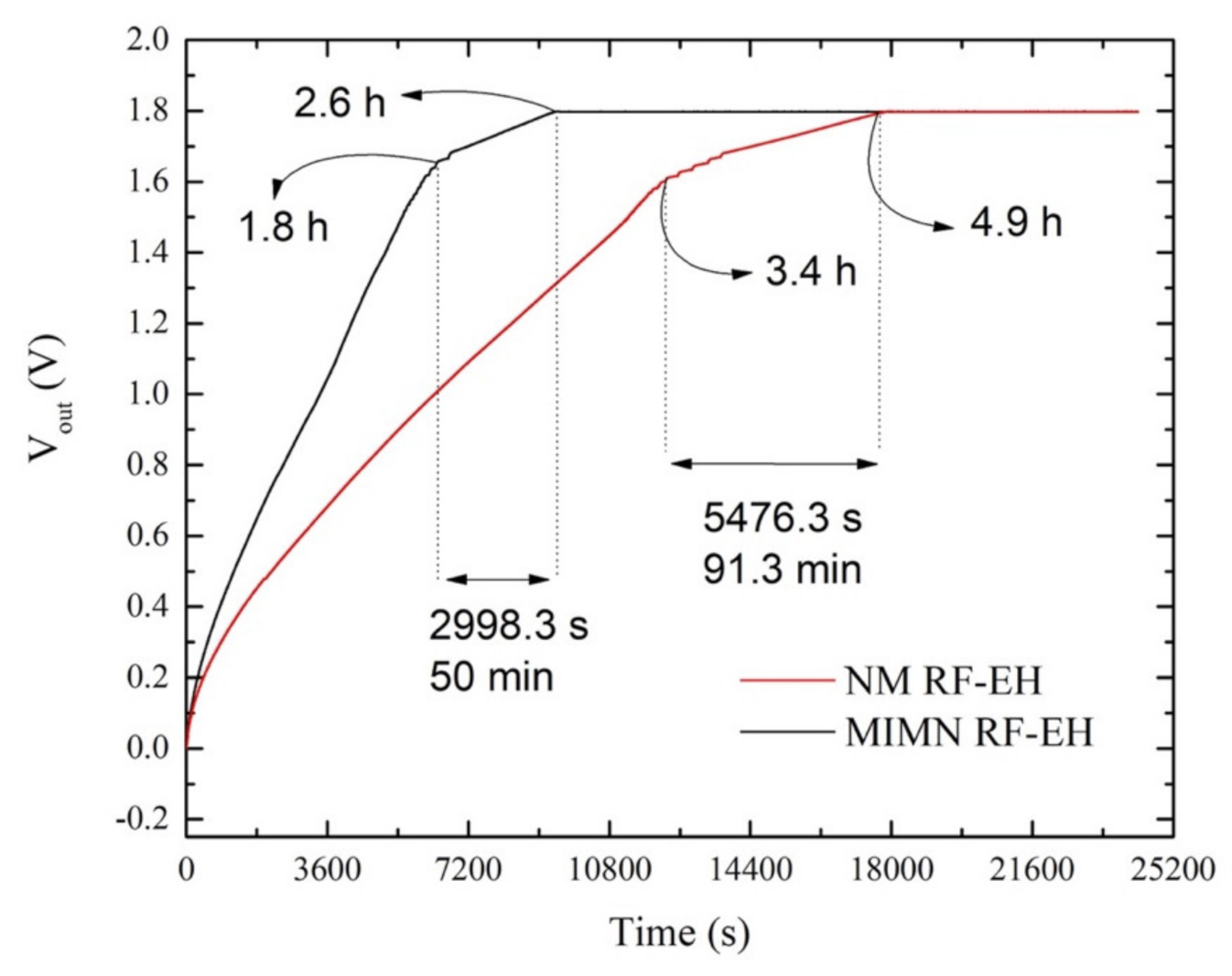
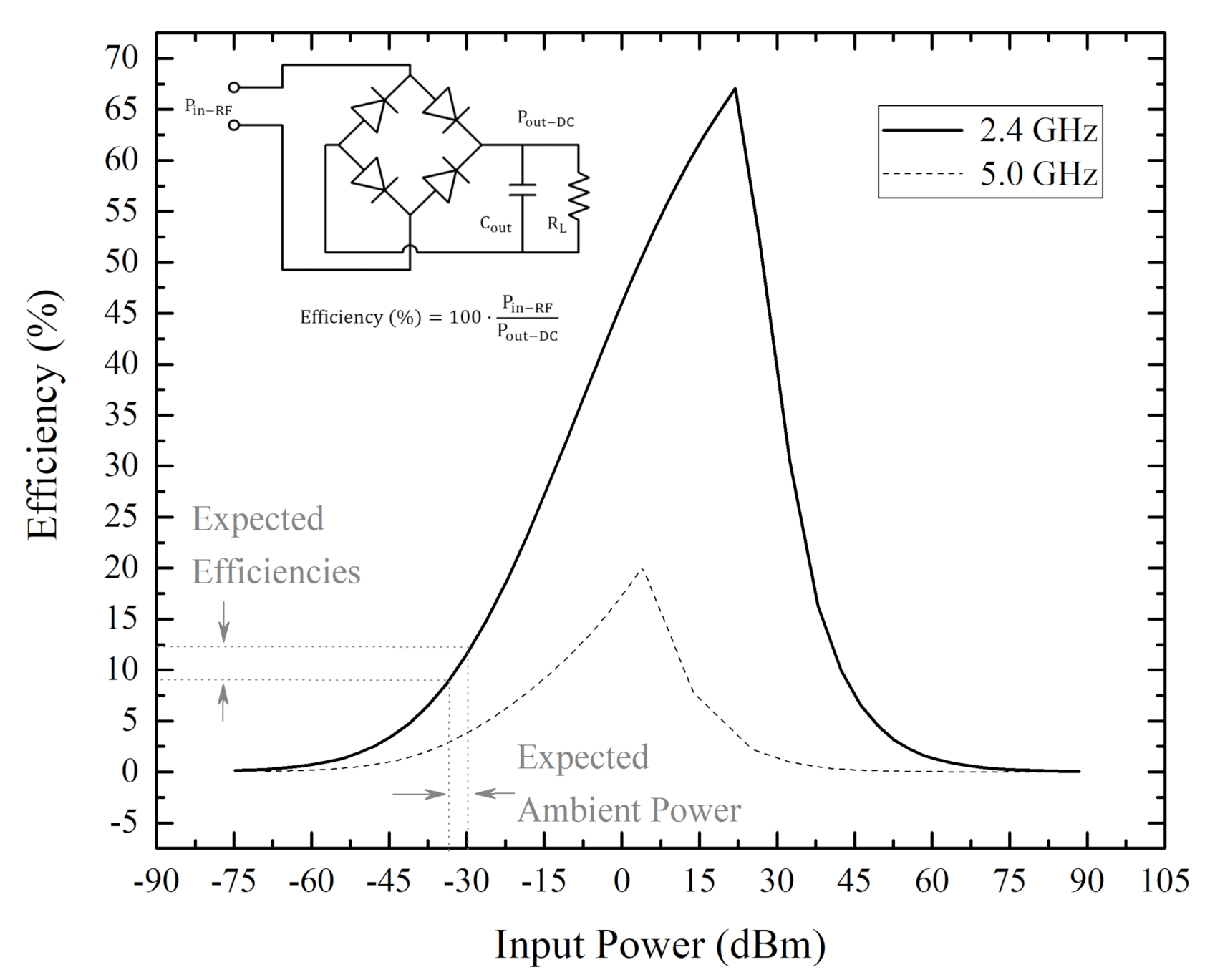
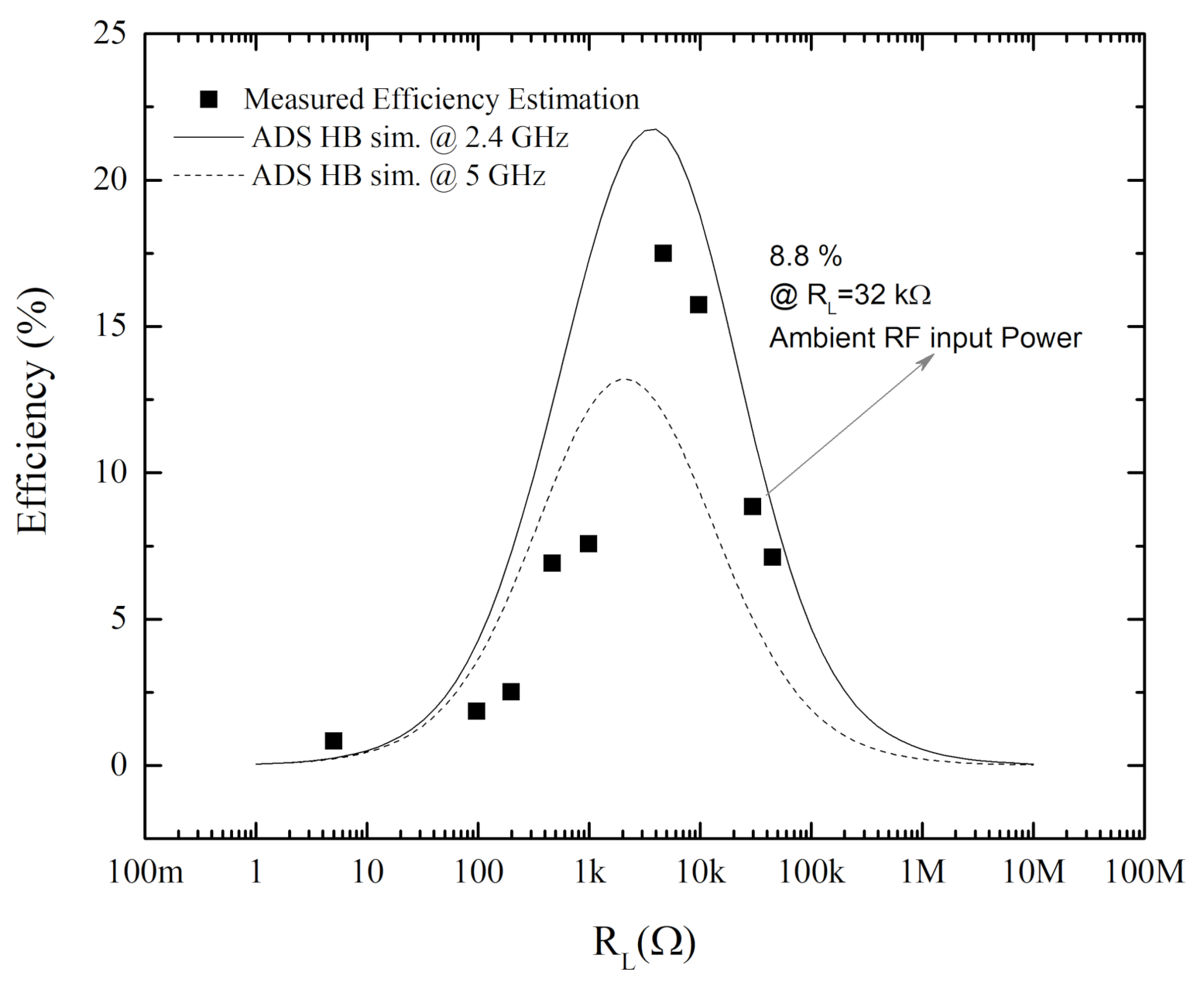

| References | Frequency (GHz) | Input Power | Diode Type | RF-to-DC Efficiency (%) | |
|---|---|---|---|---|---|
| [49] | 2.4 | −10 dBm | |||
| SMS7630 | 2.8 k | 10 | |||
| [50] | 2.4 | −20 dBm | SMS7630 | 5.3 k | 18 |
| [52] | 2.45 | −30 dBm | HSMS 2852 | 28 k | 10 |
| This Work | 2.4 | RF-Ambient (<−30 dBm) | SMS7630 | 32 k | 8.8 |
Publisher’s Note: MDPI stays neutral with regard to jurisdictional claims in published maps and institutional affiliations. |
© 2021 by the authors. Licensee MDPI, Basel, Switzerland. This article is an open access article distributed under the terms and conditions of the Creative Commons Attribution (CC BY) license (https://creativecommons.org/licenses/by/4.0/).
Share and Cite
Coskuner, E.; Garcia-Garcia, J.J. Metamaterial Impedance Matching Network for Ambient RF-Energy Harvesting Operating at 2.4 GHz and 5 GHz. Electronics 2021, 10, 1196. https://doi.org/10.3390/electronics10101196
Coskuner E, Garcia-Garcia JJ. Metamaterial Impedance Matching Network for Ambient RF-Energy Harvesting Operating at 2.4 GHz and 5 GHz. Electronics. 2021; 10(10):1196. https://doi.org/10.3390/electronics10101196
Chicago/Turabian StyleCoskuner, Ertugrul, and Joan J. Garcia-Garcia. 2021. "Metamaterial Impedance Matching Network for Ambient RF-Energy Harvesting Operating at 2.4 GHz and 5 GHz" Electronics 10, no. 10: 1196. https://doi.org/10.3390/electronics10101196






